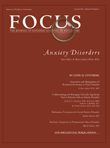What Is an Anxiety Disorder?
Abstract
Initiated as part of the ongoing deliberation about the nosological structure of DSM, this review aims to evaluate whether the anxiety disorders share features of responding that define them and make them distinct from depressive disorders, and/or that differentiate fear disorders from anxious-misery disorders. The review covers symptom self-report as well as on-line indices of behavioral, physiological, cognitive, and neural responding in the presence of aversive stimuli. The data indicate that the anxiety disorders share self-reported symptoms of anxiety and fear; heightened anxiety and fear responding to cues that signal threat, cues that signal no threat, cues that formerly signaled threat, and contexts associated with threat; elevated stress reactivity to aversive stimuli; attentional biases to threat-relevant stimuli and threat-based appraisals of ambiguous stimuli; and elevated amygdala responses to threat-relevant stimuli. Some differences exist among anxiety disorders, and between anxiety disorders and depressive disorders. However, the differences are not fully consistent with proposed subdivisions of fear disorders vs. anxious misery disorders, and comparative data in large part are lacking. Given the high rates of co-morbidity, advances in our understanding of the features of responding that are shared across vs. unique to anxiety and depressive disorders will require dimensional approaches. In summary, the extant data help to define the features of responding that are shared across anxiety disorders, but are insufficient to justify revisions to the DSM nosology at this time.
(This Article is being co-published by Depression & Anxiety and the American Psychiatric Association. This Article first appeared in Depression & Anxiety, 26:1066–1085 (2009).)



